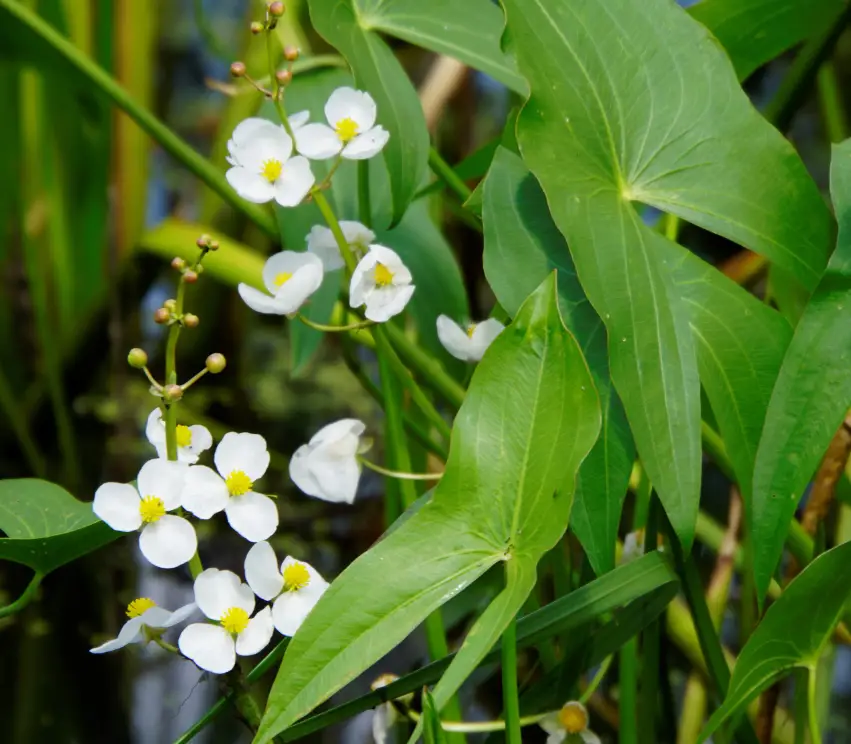Katniss (Sagittaria latifolia) is a hardy aquatic plant native to North America, renowned for its arrowhead-shaped leaves and edible tubers. Often found in wetlands and along the edges of ponds and rivers, Katniss has gained popularity among gardeners for its unique beauty and its ability to attract wildlife, including birds and pollinators.
This guide will provide detailed insights on how to grow and care for Katniss plants, along with ultimate tips to ensure your plant thrives in any aquatic or semi-aquatic environment.
Overview of Katniss Plant

Before diving into care and maintenance, let’s explore a bit about the Katniss plant itself.
- Scientific Name: Sagittaria latifolia
- Common Names: Katniss, broadleaf arrowhead, duck potato, wapato.
- Plant Type: Perennial aquatic plant.
- Hardiness Zones: USDA zones 3 to 10.
- Mature Size: Typically grows 2-4 feet in height.
- Bloom Time: Summer to early fall (July to September).
- Flower Color: White, with three petals.
- Light Requirements: Full sun to partial shade.
- Water Needs: Prefers standing water or constantly moist soil.
- Soil Type: Clay, loam, or sandy soil that remains wet.
Benefits of Growing Katniss Plant
Katniss plants provide multiple benefits, both to your garden and the surrounding environment.
- Wildlife Attraction: Katniss plants are excellent for creating a biodiverse garden. Their flowers attract pollinators such as bees and butterflies, while their leaves provide cover for small aquatic creatures. The tubers are a food source for animals like muskrats and waterfowl.
- Edible Tubers: One of the unique aspects of Katniss is its edible tubers, sometimes referred to as duck potatoes. These tubers have been harvested by indigenous peoples for centuries. They can be boiled, roasted, or eaten raw, and taste similar to potatoes or chestnuts.
- Aquatic Garden Enhancement: Whether you have a backyard pond or a decorative water feature, Katniss adds an eye-catching vertical element with its arrowhead-shaped foliage. Its ability to thrive in waterlogged conditions makes it ideal for marginal areas in ponds or streams.
- Erosion Control: Katniss is also an excellent plant for controlling erosion along water bodies due to its robust root system, which helps stabilize soil and prevent runoff.
How to Grow Katniss Plant
Growing Katniss is relatively easy, especially if you have a water garden or a moist area in your yard. Here’s a step-by-step guide to growing Katniss from planting to propagation.
Choosing the Right Location
Katniss thrives in sunny locations with ample water. Ideally, select a location that receives at least six hours of sunlight per day. While the plant can tolerate partial shade, full sun encourages healthier growth and better flowering.
- In a Pond or Water Garden: Katniss can be grown in shallow water (6-12 inches deep). Plant it in containers or directly into the substrate at the edge of the water.
- In Moist Soil: Katniss can also be grown in consistently wet or marshy areas. If you don’t have a pond, consider creating a rain garden or moist bed to house these plants.
Soil Preparation
Katniss prefers rich, organic soil that retains moisture. If you’re planting it in a pond, it’s important to use soil that won’t float or cloud the water. A mix of clay or loam with organic compost is ideal.
For soil-grown Katniss, ensure the planting area remains constantly wet. Amend the soil with compost or other organic material to improve water retention if needed.
Planting Katniss
Katniss can be planted from seeds, tubers, or transplants. Here’s how to handle each method:
- From Seed: Seeds should be started in shallow trays with a waterlogged medium, such as a peat and sand mix. Keep the trays in a warm, sunny location. Once the seedlings are 4-6 inches tall, they can be transplanted into the ground or water.
- From Tubers: Plant tubers directly into the soil, burying them 2-3 inches deep. Make sure they remain consistently moist or submerged in shallow water.
- Transplants: Katniss can be transplanted from containers to the desired location once it reaches a height of 6-12 inches. Be sure to water the plant thoroughly after transplanting.
Watering and Maintenance
Katniss requires consistently wet soil or shallow water to thrive. If you are growing the plant in the soil, regular watering is necessary to keep the area damp. A layer of mulch around the base of the plant can help retain moisture.
- Pond Grown: If planted in a pond, make sure the water depth is appropriate (no more than 12 inches). Katniss can tolerate fluctuating water levels, but consistent exposure to water is key.
- Soil Grown: In areas prone to drying out, consider using a drip irrigation system to keep the soil consistently moist.
Fertilizing
Katniss is not a heavy feeder, but providing nutrients can enhance growth. If your plant seems slow to grow or if the leaves start yellowing, apply a balanced aquatic fertilizer. Use slow-release tablets for pond-grown Katniss or organic compost for soil-grown plants.
Pruning and Deadheading
To encourage prolonged blooming, deadhead the spent flowers by snipping them off at the base of the flower stalk. This helps direct energy toward new growth and tuber production.
In late fall, as the plant dies back, prune the foliage down to the ground. This helps prepare the plant for dormancy and encourages healthy regrowth in spring.
Winter Care
Katniss is hardy in zones 3-10, making it tolerant to cold and frost. In colder zones, the plant will go dormant in winter. If grown in a pond, ensure that the water doesn’t freeze completely, as this could damage the tubers. In soil, applying a layer of mulch can provide extra insulation during harsh winters.
Propagation of Katniss
Katniss plants can be propagated through seed or tuber division.
- From Seed: Collect seeds from mature flower heads in late summer or early fall. Dry them and store in a cool, dry place over winter. In spring, start the seeds in shallow trays as described above.
- Tuber Division: Every few years, divide the tubers to control the plant’s spread and rejuvenate growth. Carefully dig up the tubers in early spring or fall and separate them, making sure each division has at least one growing eye. Replant the divisions in their new locations.
Common Pests and Problems
Katniss is relatively pest-free but can encounter a few challenges:
- Aphids: These small pests can infest the leaves, causing them to curl and yellow. A strong spray of water or an application of insecticidal soap can help control aphids.
- Leaf Spots: In wet, humid conditions, Katniss may develop leaf spots caused by fungal infections. Remove affected leaves to prevent the spread, and ensure proper air circulation around the plant.
- Overgrowth: Katniss can become invasive if left unchecked. Regularly divide the plants to keep them in check and prevent them from overtaking your water feature or garden.
Ultimate Tips for Growing Katniss Successfully
To ensure your Katniss plant thrives, keep these expert tips in mind:
- Sunlight is key: Although Katniss can tolerate partial shade, it flourishes in full sun. Aim for at least six hours of direct sunlight each day.
- Keep it wet: Whether planted in a pond or in soil, Katniss needs consistently moist conditions. Waterlogged soil is ideal, so don’t let it dry out.
- Deadhead regularly: Removing spent blooms encourages new flowers and keeps the plant looking tidy.
- Divide regularly: Every two to three years, divide the plant to control its spread and promote vigorous growth.
- Use rich soil: Katniss thrives in nutrient-rich, organic soil. If necessary, supplement with compost or slow-release aquatic fertilizers.
Conclusion
Katniss is a versatile, beautiful plant that enhances both water gardens and wetland areas. Its distinctive arrowhead-shaped leaves, delicate white flowers, and edible tubers make it a unique addition to any landscape. By following the tips outlined in this guide, you’ll ensure that your Katniss plant remains healthy, vibrant, and an attraction for wildlife year after year.






